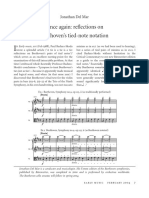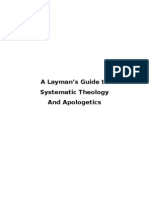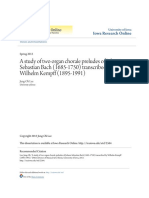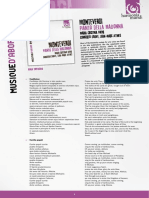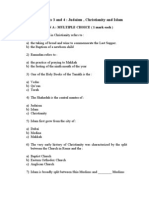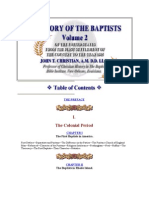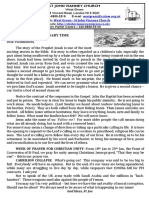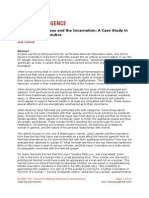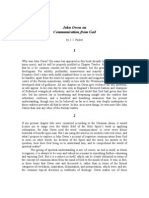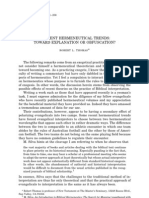On A Continuo Part by Palestrina
On A Continuo Part by Palestrina
Uploaded by
Andrew PassmoreCopyright:
Available Formats
On A Continuo Part by Palestrina
On A Continuo Part by Palestrina
Uploaded by
Andrew PassmoreOriginal Description:
Original Title
Copyright
Available Formats
Share this document
Did you find this document useful?
Is this content inappropriate?
Copyright:
Available Formats
On A Continuo Part by Palestrina
On A Continuo Part by Palestrina
Uploaded by
Andrew PassmoreCopyright:
Available Formats
On a Continuo Organ Part Attributed to Palestrina
Author(s): Patrizio Barbieri
Source: Early Music, Vol. 22, No. 4, Palestrina Quatercentenary (Nov., 1994), pp. 587-605
Published by: Oxford University Press
Stable URL: http://www.jstor.org/stable/3128191 .
Accessed: 25/04/2014 06:59
Your use of the JSTOR archive indicates your acceptance of the Terms & Conditions of Use, available at .
http://www.jstor.org/page/info/about/policies/terms.jsp
.
JSTOR is a not-for-profit service that helps scholars, researchers, and students discover, use, and build upon a wide range of
content in a trusted digital archive. We use information technology and tools to increase productivity and facilitate new forms
of scholarship. For more information about JSTOR, please contact support@jstor.org.
Oxford University Press is collaborating with JSTOR to digitize, preserve and extend access to Early Music.
http://www.jstor.org
This content downloaded from 194.73.71.3 on Fri, 25 Apr 2014 06:59:31 AM
All use subject to JSTOR Terms and Conditions
PatrizioBarbieri
On a continuo organ part
attributed to Palestrina
he earliest mention of the use of the organ for liturgicalpurposes
in 16th-centuryItaliantreatises is by Biagio Rossetti (1529).Even
N i=?
though Rossetti'sdescription is not always clear, it seems to suggest
IO.A.N 1PE T'R
Mtft I. in ba'filica
that at the time the organist'srole was limited to alternatimperfor-
S.R-etrt oe
'.b'~i.citnt
IS.. cap~pellac mances with the choir.'The first clear examples of bassusad organum
-i .. v rtl .i are found towardsthe end of the century,in works by composers from
. \1
a geographicalarea that encompasses the Veneto and Emilia regions,
1" such as Alessandro Striggio (1587),Giovanni Croce (1594) and Adri-
ano Banchieri (1595).2 To these we must add Ludovico da Viadana, a
musician from the same region, whose Centoconcertiecclesiastici[... ]
con il bassocontinuoper sonar nell'organo,although published in 1602,
were partlycomposed around 1596-7 during a short stay in Rome.3
K As for the foremost Roman polyphonist, Giovanni Pierluigida Pal-
estrina, the first example of the insertion of a basso continuo part in
his compositions dates from the first decade of the 17th century.4
There is evidence, however,that such a practice was alreadyin use in
Rome, albeit irregularly,at least as early as 1585.5Only the Sistine
1 Palestrina, Missarum liberprimus
(Rome: Dorico, 1554), title-page. Chapel, in its role as the pope's official musical chapel, remained
The composerpresentshis workto faithful to purely vocal performances, thus respecting its well estab-
JuliusIII.
W,."77f"-- lished tradition. Nevertheless, the organ was heard during the vespri
segreti (private Vespers) performed in the private apartments of the
pope. Jean Lionnet has recently demonstrated that this was surely
happening during the reigns of Paul V (1605-21) and Urban VIII
(1623-44).6 According to the documents that are the subject of the
present article,this practiceshould be shifted back to the vesprisegreti
of Sixtus V (1585-90). Of particular importance in this respect is a
basso continuo part attributedto Palestrina:this valuablepiece of in-
PatrizioBarbieri,formerlya professor formation has been found in the manuscripts left by Girolamo Chiti
of electronics,now teachesmusic (1679-1759),who from 1726to 1759held the post of maestrodi cappella
theoryand acousticsat the University at the churchof S. Giovanni in Laterano,Rome'scathedralchurch. Let
of Lecce.He haspublisheda bookand us examine the matter in detail.
about50 articleson topicsrelatedto
ancientkeyboardinstruments,musical At the conclusion of a letter of 25 September 1752,addressed to
temperament,modaland harmonic padre GiambattistaMartini, Chiti announced:
theories. Io poi h6 trovatoun mottettoa 6 del Palestrinaper la Pentecosteconcertato... col
EARLY MUSIC NOVEMBER 1994 587
This content downloaded from 194.73.71.3 on Fri, 25 Apr 2014 06:59:31 AM
All use subject to JSTOR Terms and Conditions
' fe r
'A,~., .---
...
,-__
-_-wAI-, --
,.-
E
..M.-Moso- I
e fx
..
..
.1( its
AA
!.0
~--?-?-7?
cw ;
%.w
I
588 EARLY MUSIC NOVEMBER 1994
This content downloaded from 194.73.71.3 on Fri, 25 Apr 2014 06:59:31 AM
All use subject to JSTOR Terms and Conditions
basso continuofatto dal medesimoPalestrinache l'V uno By a luckycoincidence,just when I was correcting
spavento: Dum complerentur C.A.A.T.T.B. et organo; the proofs of the present article,EleonoraSimi
questol' cosararadel nostroArchivio,e diconoservitoper li Bonini,who collaborated withotherscholarsin re-
vesperisecretidi NostroSignoreSistoVo. Ne riceveria
copia.7
organizingand reclassifyingthe musical manu-
I havealso founda six-voicemotetof Palestrinafor the
feast of Pentecost, concerted ... with a basso continuo
scriptsof S. Giovanniin Laterano,a taskfinished
writtenby Palestrina himselfthatis frightful:Dumcom- about mid-1994,kindly let me know that in the
plerentur C.A.A.T.T.B. andorgan;thisis a rareitemfrom archive of the cathedralshe had recentlyfound-
ourarchive,andtheysaidit wasusedforthe vesperi secreti undatedand in separateparts-a motet that is in
of ourLordSixtusV. Youwillgeta copy. all probabilitythe originalmentionedby Chiti;she
A copy of this motet, in Chiti'shandwritingand alsofounda statementin whichChitistatesthatthe
also dated25 September1752, is at presentin the performanceof this concertatomotettook placein
BibliotecaCorsinianain Rome (illus.2).8In this 1585,underSixtusV, on the occasionof the vespri
for Pentecost.10
manuscriptChiti repeatsthe assertionthat the segreti
motet was taken from an originalfound in the At present,however,the originalsourcethat is
archiveof S. Giovanniin Laterano.In the organ the basis of Chiti'sstatementhas not yet come to
In fact, as far as the years 1585-90 are con-
part-and specificallyat the beginningof the first, light.
secondandthirdsystems-Chiti notes: cerned, the diariesof the pontificalchapel(Diari
sistini)and thoseof PaoloAlaleonede Branca,the
[f.65v]Bassocontinuowrittenby Palestrina
[f.65v]Basso continuo written by Palestrina... motet for
pope's master of ceremonies,mention only the
theprivateVespersof ourLord[thepope] 'firstVespers'publiclyheld in the CappellaSistina
[f.66r] Basso continuo writtenby Palestrina, a rare and the day beforePentecost.(Alaleone'sdiaryis not,
noteworthy thing.9 though, determinantin this matter, since it is
almostexclusively focusedon officialceremonies.)"
As regardsthe chapel'sprivateservicefor the
2 (opposite) Openingbarsof Palestrina's motet Dum
pope in the secondhalfof the 16thcentury,the real
complerentur(Rome, Biblioteca Corsiniana e dell' situationis not
Accademia dei Lincei, Ms. Musica M.14, f.65v). At the yet completelyclear.The Diarisis-
tini showthat fromat least1563the cantoriwould
top of the page GirolamoChiti writes: 'Dum com-
plerenturPraenestinusIn FestoPentecostesAntiphona sing at noon on EasterDay, during or afterthe
a 6./ 1752Chitusstudebatex ArchivioLateranenside- pope's meal; similarduties-extended to Christ-
prompta. Concertato a 2 C. A0.' ('Dum complerenturby mas Day,New Year'sDay,Pentecost,the Feastof
Palestrina,antiphonfor the Feastof the Pentecost,a 6/ St PeterandStPaul,andtheanniversary of theelec-
Chiti studied it in 1752,having taken it from the archive tion of thepope-are alsorecordedin thefollowing
of the Lateran.Concerted,with two choirs.') The years,but only
sporadically, thoughtheywere re-
manuscriptincludesthe basso continuo attributedto ferredto as a 'usual'practice.Wefirstbeginto find
Palestrina,but lacks the first tenor part. About this mentionof the
omissionChitiremarks:'mancail primotenoreripor-
vesprisegretiin the Diari sistiniof
the years 1591and 1596, under Innocent IX (1591)
tato nel libro simile no 95 all'ultimo'('the first tenor
and Clement VIII (1592-1605):the context suggests
part is lacking, [but] it is shown in a similarbook,
thatthis kind of service,whichlookslikea natural
no.95,in the last place').Lateron we also read:'a 6. 25
settembre 1752 hora 15 Hieronijmus Chiti Romae in extension into the afternoonof the dutiesduring
aedibus Canonicis Lateraniscum voluptate studiosa the pope'smeal, was at that time by no meansa
tantiexcell.miAuctorisperitiaecc'. ('a 6. 25September novelty."1 As for the pontificate of Sixtus V, the
1752,at the 15thhour [9.30 p.m.], Girolamo Chiti in the Diari sistinido not even mention the motets during
presbyteryof the Lateran,with pleasurein studyingthe the pope's meals; also, as we have seen, they were a
skillsof suchan excellentcomposer.') normal custom. The private Vespers took place
EARLY MUSIC NOVEMBER 1994 589
This content downloaded from 194.73.71.3 on Fri, 25 Apr 2014 06:59:31 AM
All use subject to JSTOR Terms and Conditions
four times a year-on ChristmasDay, EasterDay,
NEW P A B
Pentecost and the Feast of St Peter and St Paul
and their systematicperformanceisrecordedin the
Diari sistinionly from the beginning of the reign of
PaulV. (It is only from 1605,the yearin which Paul
81~~$
V was elected, that these diariesbegin to be practi-
callycomplete and exhaustive.)On these feast-days
the cantoriof the CappellaSistina,following their
participation in morning Mass, would go to the
pontifical apartments for the customary perfor-
mance of 'motets' ('i soliti mottetti' or 'il solito
mottetto') duringthe pope'sdinner.Afterthe usual
good wishes and 'holy benediction'they remained
there until the late afternoon, waiting for the pon-
tificalprivateVespers;duringthis servicethey sang
'lively motets and short psalms' in a room ('Aula
Apostolorum')communicatingwith the small cap-
The Codex T. im. 2. Turin, Biblioteca Nazionale Univer- pella secretain which PaulV stayedalone.13
sitaria (Boverio Codex). This is all we know of the originsof the pontifical
IntroductorystudyandfacsimileeditionbyAgostinoZiino.English
andItaliantexts.In-4,172pp., 52 colourplates,hardcovers(Ars privateVespers.In the light of these documents we
Nova,3). can only conclude that no evidence has emergedto
NOW AVAILABLE ISBN88-7096-034-X
Lit.220 000 ?. 92.000 US$135.00 contradict Chiti's testimony. Independent confir-
mation is requiredbefore we may be certain that
this arrangementof Dum complerenturis indeed
the earliestknown exampleof bassoper l'organo.At
Jd~il~ any rate, as I shall show below, the bass is stylisti-
cally similarto the bassiseguentiwritten at the end
of the 16th centuryby composers such as Striggio,
Victoria and Rogier.The whole of the first part of
the motet is shown as ex.i.
Intabulations of vocal polyphony and the first
bassiper l'organo
The practiceof intabulatingpolyphonicvocal com-
positions was widespread in the 16th century. It
is logical to assume that the first bassiper l'organo
were simply reductions from these tablatures,
INGEGNERI, II terzo libro dei madrigali
MARC'ANTONIO. a from which one would take 'whichevervoice part
cinque voci. EditedbyMarcoMangani.EnglishandItaliantexts. in the composition happened at the moment to
In-4, Lv-94pp., papercovers (Marc'Antonio
Ingegneri.Opera
omnia.Serie2, Volume3). be the lowest, and therefore the real basis of the
NOW AVAILABLE ISBN88-7096-056-0
Lit.50000 ?. 22.00 US$30.00 harmony'.14 The bass of ex.i followsthis rule:see es-
LIBRERIA MUSICALE
ITALL)IYL'
A
* 1-55100
LUCCAAI
pecially bars 19, 23, 45, 55, 81. Identical procedures
can be found in other sacred compositions dating
from the same period.
590 EARLY MUSIC NOVEMBER 1994
This content downloaded from 194.73.71.3 on Fri, 25 Apr 2014 06:59:31 AM
All use subject to JSTOR Terms and Conditions
Ex.i Palestrina, Dum complerentur(the first tenor part, lacking in the Chiti manuscript, has been added; see the
remarks in the caption to illus.2). The motet also has a secundapars (Dum ergo essent), where, however, the basso
continuo is notated only for the opening bars.
Dum comrn-ple - ren-tur di - es Pen-te- co - stes,
A. ....
Dum comrn-ple - ren - tur di - es Pen-te - co -stes,
AIle.
Dum com -
T.
Dum corn-pie - ren - tur di - -
es Pen-te-co
-
stes, dum com -
T.II .
.. .-.i1
Dum com -
Dum corn -
B.C.FFO.
IF'IF
e - rant om - nes pa - ri -
I.[i.l
e - rant om - nes pa - ri -
1, Ir. ...I
- pe - ren - tur di - es Pen - te - co - stes, e - rant om - nes pa - ri -
-
-ple - ren-tur di - es Pen-te - co - stes, e - rant om - nes pa - ri-
-ple - ren - tur di - - es Pen - te - co - stes, e - rant om - nes pa - ri -
I d
-......r r i
-ple - ren - tur di - es Pen -te - co - stes, e - rant om - nes pa - ri-
EARLY MUSIC NOVEMBER 1994 591
This content downloaded from 194.73.71.3 on Fri, 25 Apr 2014 06:59:31 AM
All use subject to JSTOR Terms and Conditions
15
-ter di-cen - - tes, al - le-lu-ia, al-le - lu - ia,
-ter di- cen - - tes, al - le-lu-ia, al - le -lu - ia,
-ter di - cen - - tes, al - le-lu -ia,
-ter di - cen - - tes, al le -lu-ia, al -le -lu - ia, al-
-terdi - cen - tes, al - le-lu-ia, al - le-lu-
-ter di - cen - - tes, al le-lu - ia,
22
al-le-lu - ia, al -le-lu- ia, al-
al - le-lu-ia, al - le-lu-
I Ir', t ,
-le-lu -ia, al -le-lu - ia, al - le -lu -
- ia, al -le-lu - ia, al-
-I t - lelu l l
a! I-
-
al - le-lu - ia, al- le -lu-
I r 'rr r
al r l-
,ia, ' ' t
592 EARLY MUSIC NOVEMBER 1994
This content downloaded from 194.73.71.3 on Fri, 25 Apr 2014 06:59:31 AM
All use subject to JSTOR Terms and Conditions
29
I
-le - - lu - - ia, et su -bi- to, et su - bi - to fa-
al - le - lu - - ia, et su - bi-to, et su - bi-to, et su -bi-to
- ia, et su -bi -to, et su - bi-to,
toI-I
- ia, al - le -lu ia, et su- bi-to, et su -bi-to, et su - bi -to
- -
- le-lu ia, et su - bi-to, et su - bi-to, et su-bi-to
- - -
- ia, al le - lu - ia, et su - bi-to, et su- bi-to
iII I
36
- ctus est so - - - nus de coe - - lo, al- le -lu -ia,
Il i. I
1,
fa-ctus est so - - nus, so - - - nus de coe - - lo,
fa-ctus est so - - - nus, so - nus de coe - - lo, al - le-lu-ia,
fa-ctus est so - nus, so - nus de coe - - lo, al- le -lu -ia,
fa-ctus est so nus, so nus de c
coe lo, al le -lu -ia,
fa -ctus est so - - - nus de coe - - lo,
fa - ctus est so - - - - nus de coe - - lo,
EARLY MUSIC NOVEMBER 1994 593
This content downloaded from 194.73.71.3 on Fri, 25 Apr 2014 06:59:31 AM
All use subject to JSTOR Terms and Conditions
43
..I _.-
al-le - - lu - ia, al- le-lu-ia, al - le-lu-ia,
- wI 7,Ii,,w
al-le -lu - - ia, al-le-lu - ia, al - le-lu-ia, al-le - lu-
I =F-
J=il IJ-
-
I I
I; I
al - - le -lu - ia, al-le -lu - ia, al-
al - le - lu - - ia, al - le-lu -ia, al-
I i I i
- tI
al-le-lu -ia, al -le -lu - ia,
al-le-lu - ia, al-le-lu - ia, al - le - lu - ia,
50
al - le-lu - ia, tam-quam spi - ri-tusve-he-
-ia, al-le - lu - - ia, tam -quam spi -ri-tus ve - he-men - tis,
-le - - lu - ia, tam-
-le-lu -ia, al - le - lu - ia, tam- quam spi - ri-tus ve - he-men - tis, tam-quam spi - ri-tus ve -he-
al - le - lu - - ia, tam- quam spi -ri - tus ve-he-men - tis, spi - ri - tus ve -he-
al - le - lu - - ia, tam- quam spi - ri-tus ve he-men - tis,
594 EARLY MUSIC NOVEMBER 1994
This content downloaded from 194.73.71.3 on Fri, 25 Apr 2014 06:59:31 AM
All use subject to JSTOR Terms and Conditions
57
-men - tis, ve -he-men - tis, et re - pie - - vit to - tam do-mum, to tam
et re - pie - -vit to - - tam do-
-quam spi- ri-tus ve -he-men - tis, et re - pie - - vit to - tam do mum, to
-men tis, ve-he-men - tis,et re - pe - - - vit to - tam do - mum, do-
men tis, et re-ple vit to - tam do- mum, to tam
et re- pie - vit to - tam do mum, to
64
do-
do
-
- al
mum,
mum, al - -
le-
le - - - lu - - ia,
ia,
-
-mum, do - mum, al le lu -ia,
do amum, al le
MEOW -
r ,. . .,I , . -6,, , . . i ! - , . -
-v " - - i - - "- - II , I ' -- . I
-tam do mum, al le
EARLY MUSIC NOVEMBER 1994 595
This content downloaded from 194.73.71.3 on Fri, 25 Apr 2014 06:59:31 AM
All use subject to JSTOR Terms and Conditions
71
al - - le - lu - - ia,
JRJh i - 4.
I
I" I
al - - le -lu - !FT al -
I. Ii- i-4 - ? - - - -
ia, le lu ia,
- lu - - ia, al - - le - lu - ia, al - - le -lu-
r'Rp;-
- - ,- i4
al - - - le - lu - - - ia, al-le - - lu-ia,
S-
lu - -
ia, al - - le - lu-
-
-lu - lu- ia, al -- -- le -lu - al- - ia, ia, - al le-
-- -i le - lu
-
- uia, alleal le-lu-
78
al - - le-lu-ia, al - - - le-lu - - ia.
al - le -lu - ia, al-le - lu - ia, al - - - le - lu - - ia.
OP ia, al le lu - ia.
- ia, al le - lu - - -l a.
lu ia, al -le -lu ia, al le lu - ia.
596 EARLY MUSIC NOVEMBER 1994
This content downloaded from 194.73.71.3 on Fri, 25 Apr 2014 06:59:31 AM
All use subject to JSTOR Terms and Conditions
1 AlessandroStriggio's4o-voice motet Eccebeatam
lucem(1587)has an additionalvoice part whose title The organandvocalpolyphony
refersexplicitly to this practice: In Rome,as well as in Madrid,the firstuse of the
Bassone cavato dalle parte piu basse del 40, per sonar in organin performancesof polyphonicvocalmusic
mezzodel circolocon un tromboneper sostentamentodella is foundin NorthEuropeanculturalcircles.Indeed,
armoniaper sonarsicon organo,liuto et cimbalio viole.'5 the recordsof the CollegioGermanicoof S. Apol-
Bassparttakenfromthe lowestpartsof the 40, to be linaretell us thaton 6 January1585:
playedinthemiddleofthecirclewithatrombone, tosup- Ad Benedictusfuit organum sonatum sed extraordinarie
porttheharmony thatis to be playedbyorgan,luteand quia aderatM. VictoriacuiusBenedictuscantabatur.'1
harpsichords orviols.
AttheBenedictus theorganwasplayed, but,bywayofex-
2 Between1590and1595PhilippeRogier,the Flem- ception, because Maestro [Tomais Luisde]Victoria,
whose
ish maestroof the royal chapel of Philip II in Benedictus wasbeingsung,waspresent.
Madrid,wrotea three-choirMissaDomineDomi- Also
nusnoster,in whichthe organsupplieseachchoir sungon the samedaywas:
with its own bass part;ex.2 showsthe startof the mottetum pro Deogratias,quoderatSurgeilluminare
musicfor the firstchoir.The workalso includesa Hierusdlem, 8 vocumPrenestini,in organo.19
guion (a leader or general bass), made up of a motetfortheDeogratias-which wasSurgeilluminare
whicheverof the threeorganpartshappensat the Hierusalem foreightvoices,byPalestrina-on theorgan.
momentto be lowest.'6
In discussingthese documentsThomasD. Culley
3 Similarremarkscan be made about the works askswhatcouldbe the exactmeaningof the expres-
publishedby TomiasLuis de Victoriain Madrid sion 'motetsungon the organ',andhe suggeststhat
in 16oo,whichincludea basspartfor the organ.In it 'mayreferto a motetwhichwassungwitha basso
thisrespectthe passagein ex.3,takenfromthe two- continuopart providedby the organ, to one in
choirmotetAveMariagratiaplena,is particularly whichone (or more)of thevoicepartswasdoubled
interesting.'7 by the organ,or to a motetin whichone (or more)
Rogier,MissaDomineDominus
Ex.2 Philippe KyrieI,openingbarsof thefirstchoir.ThisMass
noster(c.159o-95),
is, as faras I know,theearliestexampleof a sacredcomposition
in chiavette,
andprovidedwitha basspartfor
organthatis already transposed (inthiscasea 4thlower).
I
Tiple -AF
L-
Ky - - ri - e e
Alto
-
.
Ky ri - e e - lei - son, (Ky- ri- e
o Tenor
Ky - - ri - e e - lei - - son, e-
Bajo
Ky - - ri - e
Organo Z: I
EARLY MUSIC NOVEMBER 1994 597
This content downloaded from 194.73.71.3 on Fri, 25 Apr 2014 06:59:31 AM
All use subject to JSTOR Terms and Conditions
Ex.3 TomasLuisde Victoria,AveMariagratiaplena,bars22-8. The organpart was addedto the 16oo Madrid
editionby the composerhimself.
ri-bus, in mu-li - e - ri-bus et be -ne - di - ctus,
- ri- bus, in mu -li-e -ri-bus et be-ne-
- bus, in mu - li - e - - ri- bus et be-ne-di -
in mu li - e - ri-bus et be - ne-di ctus, et
-ri - bus in mu -li - e - ri-bus et be -ne-di - ctus, et be -ne-
six%
II I I "F I IF
in mu - li-e -ri -bus et be -ne-di - ctus,
in mu - li - e - ri -bus et be-ne- di - ctus, et
i-rm i - pn
e - - "-buet be
-1i
in mu - - li - e - ri-bus et be-ne- di -
- r-r"- I I
all i9
6K
il
fj
of the voices was replacedby the organ'.20All three support indirectly an interesting statement made
hypotheses are perfectly plausible: in the original by the Flemish Andre de Pape in 1581:
manuscript of ex.1, for instance, the first tenor is Scimusigiturmagnoscomponistas,cum suas compositiones
missing in the vocal score, while it appears occa- cani iuberent,puerisalapas saepededisse,aliosquecantores
sionally in the continuo part, as in bar 66. It is poss- sine discrimine ubique diminuentes acriter increpuisse.
ible to conclude that the organ accompaniment malebantenim cantum ipsum, ut erat scriptum,integrum
must have been stylisticallysimilar to those found incorruptumque audire.21
in the intabulations left by Victoria (see ex.3). An We knowthereforethatthe greatcomposers,whenthey
arrangement of this type-in which all voices, hadtheirworkssung,wouldoftenslapthechoirboys,and
wouldscoldbitterlytheothersingers,withoutdistinction,
including the high ones, are doubled by the instru- to
ment-leads us automaticallyto exclude the possi- whenevertheyuseddiminutions. Theyin factpreferred
heartheirvocalpiecesaswritten,wholeanduncorrupted.
bility that singers might have added extempor-
aneous ornamentations to their parts. This would De Pape's assertions do not, of course, apply
598 EARLY MUSIC NOVEMBER 1994
This content downloaded from 194.73.71.3 on Fri, 25 Apr 2014 06:59:31 AM
All use subject to JSTOR Terms and Conditions
automatically to the Roman singers, although in respected, but there were some exceptions. As we
the Cappella Sistina the party of the Franco-Flem- can see in ex.2, one of these is Rogier's Missa
ish cantoriwas still very strong in 1583,as shown by Domine Dominus noster,which is, as far as I know,
Giuseppe Baini."2 the oldest example of a sacred composition in chia-
vetteto have a bass part for the organ alreadytrans-
Chiavette posed.
As we can see from ex.1, Palestrina'sDum comple-
continuo
renturuses chiavette(i.e. the bass part in baritone Imitative polyphony and
clef, the two tenors in alto clef, etc.). This implies In the continuo parts we have already examined
that during the performance the organ part was (e.g. ex.2) even the initial subjects of the counter-
transposed. Depending on whether the piece was point were doubled melodically by the organ. As
notated with a B6 or not, contemporary perfor- Peter Williams has remarked, one of the as yet
mance practice prescribed that the transposition unsolved questions in figured bass playing is 'to
occur at the lower 4th or the lower 5th, respectively. know when composers no longer expected con-
Such a rule, which has a rational justification, is tinuo playersto double themes and answersin a fu-
consistently applied in the 16o8Venetian edition of gal exposition'."4 However, at least with regard to
Palestrina's Mottetti a cinque voci. Lib. IV. The Italy,we can say that this practice was still alive in
organ part of all 29 compositions included in this 1766,when Giuseppe Paolucci stated:
print is alreadytransposed 'for the ease of the organ sipubaccompagnare laparte[vocale]acutacon
all'unisono
player'.23 la partedell'organo;cib fine renderpiirsensibilel'en-
e a di
In the late 16th century this rule was generally tratadelsoggetto, e talmododi scriverelapartedell'organo
KEYBOARD MUSIC ANTHOLOGIES
Dal clavicembalo al pianoforte a Firenze New Music for Harpsichord
Sonate di Gaetano Sborgi, Angiolo Magnelli e Niccolb Pieces by Giinter Bialas, Johannes Driessler, Karl
Morani. Reprint of the original edition. Marx, Hugo Distler, Karl Schfifer etc.
PAB 92 ? 22.00 BA 3804 ? 12.55
Early English Keyboard Music from the Mulliner Organa Hispanica: Iberian Music
Book from the 16th - 18th Centuries
14 Pieces by Richard Allwood, William Blitheman, Bk.7: Carlos Seixas - Selected Sonatas Nos I-XV
Churchyard, Thomas Mulliner, William Munday etc. WM 2726 ? 10.55
BA 2663 ? 4.85
Sonatas para tecla do sdculo XVIII
Keyboard Music from Earlier Times 11 Sonatas by Francisco Xavier Bachixa, Frei Jacinto
11 Pieces by Jacques Champion de Chambonnibres, do Sacramento, Frei Jos6 de Sant'Ana, Frei Manuel de
Girolamo Fescobaldi, Johann Kuhnau etc. Santo Elias and Carlos Seixas.
WM 1773 ? 6.15 PM 38 ? 19.95
Please ask for a copy of our complete Keyboard Music catalogue
BARENREITER
Burnt Mill, Elizabeth Way, Harlow, Essex CM20 2HX, UK
Tel (0279) 417134 Fax (0279) 429401
EARLY MUSIC NOVEMBER 1994 599
This content downloaded from 194.73.71.3 on Fri, 25 Apr 2014 06:59:31 AM
All use subject to JSTOR Terms and Conditions
da alcuni vien detto scriverein chiavette,cioe servirsidi calledby some 'writingin chiavette',that is using clefs that
chiavi che non son propriedellaparte dell'organo,tantopii are not properly usedin organscores,especially since
che questechiavisi suonanomoltevolte con uno, o con due theseclefsareoftenplayed withonlyoneor twofingers,
diti solamente,senza la riempituradell'accompagnamento withoutthefullness provided by thewholeaccompani-
intiero.25 ment.
one can accompanythe high [vocal] partwith the organat Sucha useof thetermchiavette-whichto us seems
the unison; and this so that the entranceof the subjectwill unusual-is confirmedby the TuscanGiuseppe
be betterheard,and such a way of writingthe organpartis
Becheriniin a brieftreatiseof 1813.26
Organsin Rome
A questionof some importancefor the modern
performeris whattype of positiveorganwas used
for the vesprisegretithat took placein the private
pontificalapartments.The answeris definitelynot
simple,sincethe only surviving16th-century posi-
tive organ-likely to be of Romanprovenance-is
that formerlyin the HeyerCollectionin Cologne,
and now in Leipzigin the Musikinstrumenten
Museumof the University(illus.3).The old cata-
logueof thecollectiondatesit c.153o. Eventhoughit
bearsthe armsof the DellaRoverefamily(a family
originallyfrom Savona,famousfor havinggiven
the churchthe popes SixtusIV and JuliusII), the
dioi
factthatit camefrom'aconventnearRome'makes
it verylikelythat it is of Romanprovenance.This
instrumentis at 4'pitch,withonly threestops,en-
tirelymadeup of open metalpipes:Principale4',
Ottava2',Quintadecima Accordingto Agazzari
1'.27
(1607),when positivesof this type wereemployed
in the realizationof a continuopart,the 8' pitch
couldalsobe providedby a trombone.28 The range
of the keyboard(F-G-A-Bb ... c"') is perfectly
adequateforthe performance of ex.1.
The next oldestsurvivingpositiveorganis also
built on the classicalthree-partplan,with its cen-
tralpipesin the outwardshapeof a spiral,andis at
8' pitch. Built in 16o8 by Armodio Maccioni,a
famous organ builderwho workedalso for the
papalcourt, it was given the followingsix stops:
Principale8', VIII,XV,XIX,XXII,[Flautoin XII?].
This organ was still in Rome in 1973-4, but its pre-
3 16th-century positive organbearingthe coat of arms sent whereaboutsare unknown.29
of the Della Roverefamily(from the catalogueof the Apart from instruments of this type, in late 16th-
Heyer collection, Cologne, 1913,no.241) century Rome there must also have been numerous
600 EARLY MUSIC NOVEMBER 1994
This content downloaded from 194.73.71.3 on Fri, 25 Apr 2014 06:59:31 AM
All use subject to JSTOR Terms and Conditions
organs built in a shape similar to that of a small
table.30At any rate, the earliest referencesto such
instruments date from the beginning of the next
??1,1 . I: ii n u ~~AI~PP41L;r~!
century: a 16o8 inventory of instruments from the ii Li II C! e ?rn;?~,g~t;?r~;!~i~~:r
Filippini oratorio of the Vallicellalists an organ 'in ?i;???
:t:
??~r~r~~t,
!~c~I~T,
~?????
5\
i ?(:
the shape of a small table' is listed.3'Even though ~4~
~ ?:'
?";
.y~t? C1~\ ??
the inventory does not provide further details, we C
:?
rnr
ir' I '~
can exclude the possibility that it might refer to ,?
r ?
:?
a regal because two other 17th-centurydocuments .-~t~ r
s~a; "`r? ;??
suggest that-at least in Baroque Rome-this de-
?-' i
?? ,F'4f~1 ???
C?::???
scription was used to identify organs with flue
pipes, which were primarilyused as accompanying
?re ~
instruments.
The first document dates from 1617, and dis-
cusses an instrument built by Francesco Maria
--? 1Iii
Tibaldi for the chapel of the apostolic palace of the F
Quirinale, then in its finishing stages. The Quiri- ?? ..
nale had been the papal residence since the time of
Sixtus V. This 'organ in the shape of a small table' ..., ,,
had five ranks of pipes made of cypresswood, pre-
sumably at 8' pitch: 'Principale ordinario, Princi- 4 Wing-shaped positive organ (late 17th century,
pale flauto, Ottava in flauto, Ottava ordinaria, et Romanschool) with paintedmarblingand grotesque
Quintadecima.'32This document is also important decorations;it was seen in 1970 at the GalleriaAnti-
because it is one of the few to record a flute stop at quariaSangiorgi,Rome.
pitch together with the Principale, a characteristic
that in Rome became standardaround the middle in the showroom of the Roman antique dealerSan-
of the 18thcentury,but only in instrumentsbuilt by giorgi, but whose present whereabouts are not
J. C. Werle. As is generally known, in the classical known.36
Italian organ the flute family traditionally begins
from that 'in ottava'. Registration
The second document is dated 1662, and con- Concerning the registration preferred for these
cerns 'an organ in the shape of a small table',built bassiper l'organo,the earliest Italiansources at our
by Giuseppe Testa for the Pamphili princes, and disposal date from the early 17thcentury:Ludovico
provided with four stops: 'Principale, Ottava, da Viadana (1602), Costanzo Antegnati (16o8),
Quintadecima and Flauto'.33 Claudio Monteverdi(1610o) and ErcolePorta (1620).
A third type of typically Roman instrument that In motets with up to four or five voices the Princi-
should be mentioned is the 'positivo ad ala', so pale is thought to be sufficient,bearing in mind the
called because its pipes are placed in descending fact that the volume can be increased by filling in
order from left to right, thus forming the shape of chords and reinforcingthe bass with the pedals as
a wing. This type of organ is described and praised needed. When the number of voices reachessix-as
in a treatiseof 1652by Antonio Barcotto;34its diffu- in Palestrina'sDum complerentur-one can also
sion is documented only from around 1618-20.35 add the Ottava, and sometimes even the Quinta-
There are very few surviving wing-shaped organs. decima. Monteverdi, for instance, prescribed this
Illus.4 shows an instrument that as late as 1970was combination for his Vespri della Beata Vergine.
EARLY MUSIC NOVEMBER 1994 601
This content downloaded from 194.73.71.3 on Fri, 25 Apr 2014 06:59:31 AM
All use subject to JSTOR Terms and Conditions
A I ' ali
.A.el
MI A
-
IFt Ii4ll . .-s.
-I-At _ _ &
I-
-d _-
o w l
.14l ....
c ~ ~ ~. ~ Ich Cr .r ~t6
"?.tC''L)~';8'I~
~~E
~l1
-LV I
? -i V L-4& VI -) r
SJz--t/ "iP\ P I " |tJ~
?" ' `1 TI
?, =T_P/llluc
___ ~ {...... A v 'c
A a r/ ;.-T.. e.
A. ..
ll i
Al T. . .. ' "
o-. j,A--I " _t__1 1Ii dli
i I!1.I ,I - i?EM q..
/-,,~l iIl. '.=l 4 , ! v P ?J
,_r
gig- ...I:!
- '...a
17.
, ,
_
li -M
.... T.l.o. . ,. .( . ..,r 'l
" ;
"I .. .. .- . '
-':
.; --' , . . 4 . A_ tx
"
...
li. . .. .-
ill '10010p,.
.. .. i 'A
"'
,'"
t ~IZ . r~~~'. ? I-.CII
3%`~ ....1 ---~)
/~
L", ,. / 1,
j"
"
- ?' - u p" o
. .
"
".
ee, .:e
.....
V.'.
:,:
__ e.... C-
5 Chiti's transcriptionof Morales's0 sacrumconvivium,which, however,he attributesto Palestrina(Rome,
BibliotecaCorsinianae dei Lincei,Ms. MusicaM.14,f.1o8r)
602 EARLY MUSIC NOVEMBER 1994
This content downloaded from 194.73.71.3 on Fri, 25 Apr 2014 06:59:31 AM
All use subject to JSTOR Terms and Conditions
It might also be acceptableto use Principaleand Flauto in ottava (or century', Early music, xv (1987), PP-4-5.
Lionnet, 'Palestrina e la Cappella
Principale, Ottava and Flauto in ottava), following the registrations pontificia', Atti del II convegno inter-
recommended by Antegnati 'to play all sort of things and to concertare nazionale di studi palestriniani, ed. L.
motets'.37 Bianchi and G. Rostirolla (Palestrina,
1991),p.130o.Lionnet, 'The Borghese
family and music during the first half
A misattribution of the seventeenth century', Music and
letters,lxxiv (1993), PP.519-22.
Finally I should point out that, further on in the manuscript that
includes Palestrina'sDum complerentur,Girolamo Chiti also listed at 7 Bologna, Civico Museo Bibliografico
Musicale, Ms. 1.6.34:G. Chiti (Rome,
a later date a motet, O sacrumconvivium,with the following remarks 1752,'fromthe Lateran')
25September
(illus.5): to G. B. Martini(Bologna).
Mottettoa5 vociconil bassocontinuoadlibitum.Cosiritrovato
benchealloranon 8 Rome, Biblioteca Corsiniana e
usasse:del Sig. Gio.PierLuigida Palestrina.Chitus16 Agosto1753.38 dell'Accademia dei Lincei, Ms. Musica
M.14, ff.65v-67v. An accurate descrip-
Five-voicemotetwith the bassocontinuoad libitum.Found[arranged] this tion of the entire manuscript can be
wayeven thoughthiswas not done
usually in thosetimes;
by Gio.
Sig. PierLuigi found in O. Mischiati, 'Il manoscritto
daPalestrina.
Chitus16August1753. corsiniano dei Ricercaridi Giovanni
Pierluigi da Palestrina', Atti del II con-
Actuallythis motet turns out to be not by Palestrina,but by the Span- vegno internazionaledi studi palestrini-
ani, pp.177-201. The manuscript, as
ish composer Crist6balde Morales (c.1500-53),who from 1535to 1545 Mischiati notes (p.182), dates from the
was a member of the papal chapel.39This basso continuo part presents second half of the 16th century, with
the same characteristicsof that of ex.i. additions in the hand of Girolamo
Chiti in the spaces left blank by the
The manuscript of the BibliotecaCorsinianais also remarkablefor original copyist.
a few compositions-in eight and 12 voices-transcribed by a late
9 'Basso continuo del Palestrina fatto
16th-centurycopyist, which Oscar Mischiati considers valuable evid- da esso./! Basso continuo del Palestrina
ence of the first appearanceof the basso continuo. In this manuscript, fatto da esso ... Mottetto per i vesperi
segreti di Nostro Signore./ Basso
only the first choir of these compositions is transcribedin full score: continuo del Palestrina, cosa assai
for the second and third choirs only the basso continuo parts are rara, e da osservarsi.'
notated, without the text.40 io Eleonora Simia Bonini will present
Translated byGiulioOngaro her findings at the 'Terzo Convegno
internazionale di studi Palestrina e
l'Europa',Palestrina, 6-9 October 1994.
In 1585Pentecost fell on 9 June, just a
1 BiagioRossetti,Libellusde rudimentis Mottetti a cinque voci. Lib. IV (Venice: month and a half after the election of
musices(Verona,1529),fol. nIl. An Raverio, 1608). Sixtus V. By an odd coincidence,
Italiantranslationof this passagecan May-June 1585was the very period
be foundin E. Pagnuzzi,'Medioevo 5 For a summary of the evidence see
G. Dixon, 'The performance of Pal- in which Palestrina tried-unsuccess-
e Rinascimento',La musicaa Verona estrina: some questions, but fewer fully-to be elected magisterof the
(Verona,1976),pp.115-16. Biagio answers', in the present issue of Early pontifical chapel.
Rossettiwasthe organistof the music. As far as the Cappella Giulia is
cathedralin Verona. 11 See Rome, Biblioteca Apostolica
concerned, however, only in the year
Vaticana, Fondo Cappella Sistina,
2 SeeF. T. Arnold,Theartof accompa- 1600 we find we find the first mention
Diari sistini, nos.14 (1585)and 16
nimentfroma thorough-bassasprac- of polyphonic compositions (motets)
(1587-91);see also in the same library,
tisedin theXVIIth& XVIIIthcenturies performed with the organ accompani- Mss. Vat. lat. 12427-12429:Paulus
(London, 1931),pp.6-7; P. Williams, ment: see G. C. Rostirolla, 'La Cappella
Alaleo de Branca [Diaria, 1582-1621].
'Continuo',New Grove,iv, pp.685-99, Giulia in San Pietro negli anni del It is also worth while remarking that
esp.pp.685-6. magistero di Giovanni Pierluigi da these sources tell us absolutely nothing
Palestrina', Atti del Convegnodi studi about Sixtus V's activity on the after-
3 SeewhatViadanahimselfwritesin palestriniani, ed. F. Luisi (Palestrina,
the prefaceto this work,reproducedin noon of Pentecost 1585,thus not
1977),P-137.
Arnold,Theartof accompaniment, p.3. excluding the possibility that the
6 J. Lionnet, 'Performance practice above-mentioned private Vespers
for
4 See, instance, Palestrina's in the papal chapel during the 17th could have been performed.
EARLY MUSIC NOVEMBER 1994 603
This content downloaded from 194.73.71.3 on Fri, 25 Apr 2014 06:59:31 AM
All use subject to JSTOR Terms and Conditions
12 See Diari sistini, esp. nos. 7 (Easter L. Wagner, ii (American Institute of
R. Cameron Day 1563:after the meal of Pius IV a
motet was sung, 'ut moris est'), 9 (the
Musicology, 1976), p.42. The Mass
exists also in a two-choir version, here
Baroque and Classical same on Pentecost 1572,the day on each choir has its own bass part for
Flutes which Gregory XIII was crowned), lo the organ, to which we must add the
(Christmas Day 1572:after morning general bass (guion). Philippe Rogier
For immediatedelivery: Mass 'cantavimus motettum in pran- (c.1561-96) was maestroof the Royal
dio Pontificis'; the same in 1573-6, for Chapel of Spain from 1586to his death.
Aulos Baroqueflutes the other main feasts), 11(motet on On this subject see Tomas Luis da
atA415/A440 Easter Day 1577),16 (31 October 1591, Victoria:Opera omnia, ed. F. Pedrell, i
the eve of All Saints' Day: Vespers were (Leipzig, 1902), pp.ix-xi.
Also flutesandpiccolos after.
sung in the 'Cappella secreta' before
Rafi,Hottcterre,Naust Innocent IX; a private Vespers for this 17 Victoria:Opera omnia, i, pp.146-52.
Scherer,Bressan The original edition bears the title:
particular feast was not at all usual, but T. L. da Victoria,Missae, Magnificat,
IIHRottenburgh the explanation for the exception may
G.A.Rottenburgh, Bizcy Motecta, Psalmi [...] Haec omnia sunt
be that Innocent IX-who had been
in hoc libro ad pulsandum in organis
StanesbyJr. elected two days before-would not
Cahusac,C.A. Grenser have been officially crowned until 3 (Madrid, 16oo). The organ part of the
H. Grenser motet we are discussing is usually
November), 19 (1594:'as usual' a motet limited to the first choir; however, in
C. Palanca was sung during the meal of Clement
some passages (see ex.3) it condenses
VIII, at Easter Day and for the Feast of also the parts of the second choir.
P.O.Box 438, 640 SchoolSt., St Peter and St Paul), 20 (Easter Day
CA95460,USA.
Mendocino, In 1587Victoria (c.1548-1611)had
Tel:(707) 937-0412 * 937-1259 1596,pope's private Vespers: 'i Signori moved from Rome to Madrid, where
Cantori andarono a cantar il mottetto
he held the post of maestrodi cappella
Insummermonths: dal Papa, finito [che fu], perche Nostro
39UnionStreet,Nairn in the Monasterio de las Descalzas de
IV 12 4PR - Scotland
Signore voleva il Vespro, ne fu dato Santa Clara;because of his advanced
a desinare in tinello'), 22 (Christmas
Tel:(0)667-55584
?52106. age, from 1603 to his death he was
Day 1600: Vespers in the 'Cappella
granted his request that his duties
secreta'). be limited to those of organist.
13 As for the period under Paul V 18 See T. D. Culley, Jesuitsand music, i:
see the articles by Lionnet cited in n.6,
A study of the musicians connectedwith
as well as the Diari sistini, no.24-40.
Mediaeval Concerning Paul V's Vespers, Alaleo
de Branca, Diaria, on Christmas Day
the German Collegein Rome during the
17thcenturyand their activities in
Northern Europe(Rome, 1970), p.82
Dance 1620 reports: 'Post prandium fuerunt
cantatae Vesperae privatae in Aula
and doc.89.
Collection Apostolorum a Cantoribus Cappellae
Apostolicae, coctis indutis, et Papa
19 Culley, Jesuitsand music, p.82 and
doc.9o.
Over twenty pieces from the solus stetit intus suam Cappellam 20 Culley, Jesuitsand music, p.84.
thirteenthand fourteenth privatam' ('After dinner [at noon] the
21 Andreas Papius, De consonantiis
centuries.Newly prepared singers of the apostolic chapel, wearing
their surplices, sang for the private seu pro diatessaronlibri duo (Antwerp,
from the original sources. 1581), pp.156-7. Andre de Pape (1552-
Vespers in the Apostle's Room, while
81) was, in the last years of his brief life,
Mostly monophonic- some the pope-alone-was staying in his
a canon of the collegiate church of St
two-part.Includes some private chapel').
Martin in Liege.
substantialpieces suitable 14 Arnold, The art of accompaniment,
for recital use. p.6. At any rate, in general we can say
22 G. Baini, Memorie storico-critiche
that the old Italian keyboard tablature della vita e delle operedi Giovanni
?10.99
notation did not seek to keep indi- Pierluigi da Palestrina ..., ii (Rome,
(including UK postage) vidual parts separate and recognizable, 1828), p.189.
Details, Catalogue etc, as convincingly demonstrated by 23 'pro pulsatoris organi commodi-
A. Silbiger, 'Is the Italian keyboard tate'. See P. Barbieri,'Chiavetteand
HawthornsMusic intavolaturaa tablature?',Recercare, modal transposition in Italian practice
The Hawthorns, iii (1991),pp.81-1o3. (c.1500oo-1837)',Recercare, iii (1991),
HawthornDrive, PP.39-52.
15 On this bass part, see M. Schneider,
Wheaton Aston, Die Anfiingedes Basso Continuo 24 P. Williams, 'Basso seguente', New
StaffordST19 9NG Grove.
(Leipzig, 1918),p.67.
tel (0785) 840186
16 Philippe Rogier:Opera omnia, ed. 25 Giuseppe Paolucci, Arte pratica di
604 EARLY MUSIC NOVEMBER 1994
This content downloaded from 194.73.71.3 on Fri, 25 Apr 2014 06:59:31 AM
All use subject to JSTOR Terms and Conditions
contrappunto[...], ii (Venezia, 1766), du facteur d'orgues,iv (Paris, 1778),
P-94. pl.bxxxvi-xci, and pp.558-62. Arnaldo
26 G. Becherini, Cognizionipratiche
Morelli recently informed me that
Chris topher
an interesting organ of this type is
della musica (Prato, 1813),chap.13:
'Delle chiavette'. Becherini calls currently in the Museum of Musical
Instruments of the Akademie ffir
chiavettethe clefs, other than F4,
Musik in Basel.
usedoccasionallyfor a fewbarsin a
thoroughbass staff in order to avoid 31 See A. Morelli, Il tempio armonico:
Works hops
whendoubling
ledgerlines,especially musica nell'Oratoriodei Filippini in Director. West
Jeremy
a solo performedby an uppervoice. Roma (1575-17o05) (Laaber,1991), Cornetts, &Sackbuts
Serpents
27 See KleinerKatalog der Sammlung pp.o103,181.
alter Musikinstrumente,verfasstvon
32 Barbieri,'Organi "in forma di New on the list:
GeorgKinsky:Musikhistorisches
Museum von WilhelmHeyer in Cbln
tavolino"', pp.9-10.
JeremyWestmodel
(Cologne, 1913),PP.42-3 and table 11 33 Barbieri, 'Organi "in forma di cornettA = 440 in wood
(no.241). Another valuable positive- tavolino"', pp.io-n.1
whose provenance from a hypothetical High Pitch cornett
'Roman school' of the 16th century is
34 See R. Lunelli, 'Un trattato di Anto- A = 466 in ebony resin
nio Barcotto colma le lacune dell'Arte
as yet unproven-is that of the Sil-
organica', Collectaneahistoriae musicae,
Alto cornettin F
berne Kapelle of Innsbruck. As for the
other small chamber organs owned by i (Florence, 1953),PP.135-55;esp. p.152. English Military
Renaissance popes, we have absolutely 35 On this topic see: R. Giorgetti, 'Alla three key serpent
no details about their stop-lists: at any scoperta di un raro organo ad ala', 47 ChalseyRoad
rate all the organs mentioned at that Strumenti e musica, xl (Jul-Aug 1988), London SE4 1YNEngland
time were the work of non-Roman pp.48-9; R. Giorgetti and M. Valentini,
organ builders. See R. Lunelli, L'arte 'Organi ad ala in Umbria', Strumenti e
Telephone:(44) 081 692 8321
organariadel Rinascimentoin Roma musica, xliii (Sep 1991),pp.26-3o. In Facsimile:(44) 081 694 8784
[...] (Firenze, 1958), pp.5-8. this article is mentioned an organ of
28 Agostino Agazzari, Del sonare this type, built by Armodio Maccioni
around 1618-20 and now in Perugia.
sopra'l basso con tutti li stromenti e
dell'uso loro nel conserto(Siena, 1607), Wv'-"
36 See G. Lizzani, Il mobile romano
p.3. After saying that wind instruments
are rarely used, Agazzari adds that:
(Milan, 1970),
fig.li (pp.xx,
xxviii). In Charles Wells
1965 this organ was seen, at the estab-
'sometimes the trombone in a small
group can be used as bass, when there
lishment of the same antique dealer,
Early Woodwinds
by F. Luccichenti, 'Gli Alari, organari
are small organs [playing] at the upper in Roma', Amici dell'organodi Roma,
octave: but it must be well and sweetly 2nd series, iii (1984), pp.54-62, esp.
played' ('tal volta il trombone in pic-
Maker, restorer and
p.60 (n.9).
ciol conserto, s'adopera per contra- repairer of early
basso, quando sono organetti all'ottava 37 This information comes from A. oodwind instruments
alti, ma che sia ben sonato, e dolce'). Morelli, '"Alcuni avvertimenti da farsi,
et altri da fugirsi nel suonare l'organo
29 My thanks to Domenico Devenuto
for the information concerning this sopra la parte". La prassi del basso Specialist in woodwinds
continuo all'organo nel XVII secolo', of the baroque and
organ. Andrea Taiuti, the Roman
antique dealer who sold it in 1973-4 Ilflauto dolce, x-xi (1984), p.18. A classical periods.
to an unknown German institution, revised and enlarged version of this
article will be published, in English,
has kindly informed me that inside this
in BaslerJahrbuch,xviii (1994).
organ there were very few wooden and
metal pipes left; the diatonic keys were 38 Rome, Biblioteca Corsiniana e -%6?
in ivory, with arcaded key fronts. All dell'Accademia dei Lincei, Ms. Musica
the frontal pipes were still present. M.14, ff.lo8r-lo9v.
30 See P. Barbieri, 'Organi "in forma 39 See Mischiati, 'I1manoscritto
di tavolino" del Seicento romano',
corsiniano', p.192; Crist6balde Morales: SBrochure from:
Amici dell'organo[di Roma], 2nd series, Forge Cottage, 32 Manor Road.
Opera omnia, ed. H. Anglks, ii
i (1982), pp.8-11. Instruments of this (Barcelona, 1953),PP.115-21.
Hatfield. Doncaster,
outh DN7 6SD.
type remained in use, at least in France, ~.S Yorkshire,
until the end of the 18th century: see 40 Mischiati, 'I1manoscritto corsini- .
?:. Telephone:
(0302) 846492
Dom FranCoisB~dos de Celles, L'art ano', p.180. :...
EARLY MUSIC NOVEMBER 1994 605
This content downloaded from 194.73.71.3 on Fri, 25 Apr 2014 06:59:31 AM
All use subject to JSTOR Terms and Conditions
You might also like
- Da Costa (2022) Performance Practices For Romantic and Modern RepertoireDocument36 pagesDa Costa (2022) Performance Practices For Romantic and Modern Repertoirenoor aqilNo ratings yet
- Palestrina LamentationsDocument29 pagesPalestrina LamentationsPaul DeleuzeNo ratings yet
- French Masters of The OrganDocument3 pagesFrench Masters of The OrganbeckeeNo ratings yet
- Once Again: Reflections On Beethoven'stied-Note NotationDocument20 pagesOnce Again: Reflections On Beethoven'stied-Note Notationzdanakas100% (1)
- ABO Essays - Pergolesi's Stabat Mater PDFDocument5 pagesABO Essays - Pergolesi's Stabat Mater PDFFernando Vidal Flores SarmientoNo ratings yet
- Preview: Boston University College of Fine ArtsDocument20 pagesPreview: Boston University College of Fine ArtsRodrigo Pozo100% (1)
- Pierre de La Rue Missa L'homme Arme IDocument48 pagesPierre de La Rue Missa L'homme Arme IWilliam KempsterNo ratings yet
- Arnolt Schlick's Spiegel DerDocument185 pagesArnolt Schlick's Spiegel DerTimothy EngNo ratings yet
- A Layman's Guide To Theology and ApologeticsDocument150 pagesA Layman's Guide To Theology and ApologeticsKen100% (6)
- CAVAZZONI, M.A. - Works (Complete) - Italian Ricercars (G. Wilson)Document7 pagesCAVAZZONI, M.A. - Works (Complete) - Italian Ricercars (G. Wilson)ambroise Kim ambroisesogang.ac.krNo ratings yet
- Notated and Heard Meter - LesterDocument14 pagesNotated and Heard Meter - LesterVia Das Flores Floricultura100% (1)
- MILSOM 2015 - Making A Motet - Josquins Ave MariaDocument10 pagesMILSOM 2015 - Making A Motet - Josquins Ave Mariaellakovacs0100% (1)
- ThesisDocument110 pagesThesisFranco Petrucci0% (1)
- Fleury Andre Messe de La ToussaintDocument12 pagesFleury Andre Messe de La ToussaintFabre GuinNo ratings yet
- Retorica Bach OrganoDocument33 pagesRetorica Bach Organojosefelixgz100% (1)
- Cesar Franck by Vincent D'indyDocument306 pagesCesar Franck by Vincent D'indyBruno Andrade de Britto100% (1)
- Newly Discovered Works by Giovanni GabrieliDocument22 pagesNewly Discovered Works by Giovanni GabrieliBiber Daniel100% (1)
- (Renaissance Quarterly Vol. 33 Iss. 1) Richard Sherr - Gugliemo Gonzaga and The Castrati (1980) (10.2307 - 2861534) - Libgen - LiDocument25 pages(Renaissance Quarterly Vol. 33 Iss. 1) Richard Sherr - Gugliemo Gonzaga and The Castrati (1980) (10.2307 - 2861534) - Libgen - LiLorenzo Scremin100% (2)
- Ysaye 6 Sonatas DoctoradoDocument249 pagesYsaye 6 Sonatas Doctoradoandres poggioNo ratings yet
- A Study of Two Organ Chorale Preludes of Johann Sebastian Bach (1 PDFDocument100 pagesA Study of Two Organ Chorale Preludes of Johann Sebastian Bach (1 PDFShawn HellerNo ratings yet
- Rondo Colé NW 2001Document14 pagesRondo Colé NW 2001PAULA MOLINA GONZÁLEZNo ratings yet
- BLACKBURN A Lost Guide To Tinctoris's TeachingsDocument45 pagesBLACKBURN A Lost Guide To Tinctoris's TeachingsDomen Marincic100% (1)
- Claudio Giovanni Antonio Monteverdi (Document8 pagesClaudio Giovanni Antonio Monteverdi (Jason TiongcoNo ratings yet
- Messe D'intavolatura D'organo (1568) Vol.1Document1 pageMesse D'intavolatura D'organo (1568) Vol.1ambroise Kim ambroisesogang.ac.krNo ratings yet
- Igor MarkewitchDocument5 pagesIgor MarkewitchSquawNo ratings yet
- Martin - Women Composers in Europe (1557-1750)Document101 pagesMartin - Women Composers in Europe (1557-1750)ScribdTranslationsNo ratings yet
- J. S. Bach and The Oratorio TraditionDocument169 pagesJ. S. Bach and The Oratorio Traditionellakovacs0No ratings yet
- TKN DissertationDocument179 pagesTKN DissertationAldo Hip NaranjoNo ratings yet
- John Eliot Gardiner - Mendelssohn - Symphony No. 2 Lobgesang - (LSO-Live, 2017)Document17 pagesJohn Eliot Gardiner - Mendelssohn - Symphony No. 2 Lobgesang - (LSO-Live, 2017)Carlos DaneriNo ratings yet
- Leonard Ratner - Harmonic Aspects of Classic Form PDFDocument3 pagesLeonard Ratner - Harmonic Aspects of Classic Form PDFJasna VeljanovićNo ratings yet
- Inner Repeats in The Minuet or Scherzo Da CapoDocument2 pagesInner Repeats in The Minuet or Scherzo Da CapoBono Depoorter100% (1)
- 622864Document14 pages622864Kike Alonso CordovillaNo ratings yet
- An Avant-Garde Look at Early Music: Luigi Nono's Thoughts On Sixteenth-Century PolyphonyDocument17 pagesAn Avant-Garde Look at Early Music: Luigi Nono's Thoughts On Sixteenth-Century PolyphonySinan Samanlı100% (1)
- Mozart and The Practice of Sacred MusicDocument466 pagesMozart and The Practice of Sacred Musicll3232_42459906No ratings yet
- Sacred Music, 112.2, Summer 1985 The Journal of The Church Music Association of AmericaDocument29 pagesSacred Music, 112.2, Summer 1985 The Journal of The Church Music Association of AmericaChurch Music Association of America100% (1)
- Acompañamiento Del Canto GregorianoDocument92 pagesAcompañamiento Del Canto GregorianoAntonio Valdez Alonso100% (4)
- Vogel - North German Organ Building of Late 17th CDocument6 pagesVogel - North German Organ Building of Late 17th CBenjamin MolonfaleanNo ratings yet
- 741965Document17 pages741965gazzjazz100% (1)
- Claudio Monteverdi: BarrioDocument14 pagesClaudio Monteverdi: BarrioNadir BarrioNo ratings yet
- Ligeti Signals - Long VersionDocument6 pagesLigeti Signals - Long VersionJohn Williamson100% (1)
- Obras para Piano de Fanny Mendelssohn-HenselDocument6 pagesObras para Piano de Fanny Mendelssohn-Henselmarcospablo1981No ratings yet
- The Music of Alfred Schnittke - I. Moody (1989)Document9 pagesThe Music of Alfred Schnittke - I. Moody (1989)vladvaideanNo ratings yet
- Song Settings of Heinrich Heine A Comparative Analysis of Song PDFDocument86 pagesSong Settings of Heinrich Heine A Comparative Analysis of Song PDFElena Diaz100% (1)
- FgjkelfgnklefbDocument16 pagesFgjkelfgnklefbmassiminoNo ratings yet
- List of Compositions by Olivier Messiaen - WikiDocument6 pagesList of Compositions by Olivier Messiaen - WikiiuhalsdjvauhNo ratings yet
- 10 1 1 666 4086 PDFDocument287 pages10 1 1 666 4086 PDFKern EllerNo ratings yet
- Monteverdi Pianto de La MadonnaDocument4 pagesMonteverdi Pianto de La MadonnaNube Voladora100% (1)
- Portuguese Polyphony in The Sixteenth and Early Seventeenth Centuries - Albert T. LuperDocument21 pagesPortuguese Polyphony in The Sixteenth and Early Seventeenth Centuries - Albert T. Lupereugenioamorim100% (1)
- Toscanini Textual FidelityDocument13 pagesToscanini Textual FidelityCharlie ShankNo ratings yet
- Landgren PHD The Voice of England'Document327 pagesLandgren PHD The Voice of England'Roland HendriksNo ratings yet
- Metre in Unmeasured PreludesDocument7 pagesMetre in Unmeasured PreludesCarloV.Arruda100% (1)
- Massimiliano Guido (Editor) - Studies in Historical Improvisation - From Cantare Super Librum To Partimenti-Routledge (2017) - 228Document1 pageMassimiliano Guido (Editor) - Studies in Historical Improvisation - From Cantare Super Librum To Partimenti-Routledge (2017) - 228fwqwe qwe14No ratings yet
- Organ Skills PDFDocument1 pageOrgan Skills PDFCharles DonkorNo ratings yet
- The String Quartets of MozartDocument2 pagesThe String Quartets of MozartJohn Williamson0% (1)
- Elam Rotem The Carlo G Manuscript 8930Document30 pagesElam Rotem The Carlo G Manuscript 8930maria100% (1)
- Reviews For Ligeti's Mysteries of The Macabre / Le Grand MacabreDocument4 pagesReviews For Ligeti's Mysteries of The Macabre / Le Grand MacabreNiebla VeoNo ratings yet
- Merula: Ciaconna (Su La Cetra)Document4 pagesMerula: Ciaconna (Su La Cetra)Gábor Tokodi100% (1)
- The Clarinet and The Italian Opera CompoDocument3 pagesThe Clarinet and The Italian Opera CompoElena CavaniNo ratings yet
- Cozzolani - Scherzi Di Sacra MelodiaDocument126 pagesCozzolani - Scherzi Di Sacra MelodiaFelipeNo ratings yet
- Trinitarian Bible Society Statement of Doctrine of Holy ScriptureDocument11 pagesTrinitarian Bible Society Statement of Doctrine of Holy ScriptureJohn ClarkNo ratings yet
- Part 28. A Resurrection of Life & of Judgement.Document12 pagesPart 28. A Resurrection of Life & of Judgement.ralph_knowlesNo ratings yet
- NEW Page A 02Document1 pageNEW Page A 02Damaris HigginsNo ratings yet
- Examination of ConscienceDocument2 pagesExamination of ConscienceSlobodan ObrenovicNo ratings yet
- As A Little Child - by Vance FerrellDocument100 pagesAs A Little Child - by Vance FerrellAdventist_Truth100% (1)
- The Church of God of The Abrahamic FaithDocument2 pagesThe Church of God of The Abrahamic Faithapi-3755336100% (1)
- HRF30 ExamDocument4 pagesHRF30 ExamMark BuNo ratings yet
- February 19, 2012 Worship ServiceDocument12 pagesFebruary 19, 2012 Worship Servicefergie45315No ratings yet
- A HISTORY OF THE BAPTISTS Vol. 2Document338 pagesA HISTORY OF THE BAPTISTS Vol. 2aurelomnou2812100% (1)
- Revival in The HebridesDocument8 pagesRevival in The HebridesWayne Kraus100% (1)
- Jode Holden Worship ResumeDocument3 pagesJode Holden Worship ResumeJode HoldenNo ratings yet
- Bishops Homily - 22nd Sunday in Ordinary TimeDocument19 pagesBishops Homily - 22nd Sunday in Ordinary TimeMinnie Agdeppa100% (1)
- Sinners in The Hands of An Angry God PowerPointDocument28 pagesSinners in The Hands of An Angry God PowerPointCaitlinNo ratings yet
- West Green - ST John Vianney ChurchDocument4 pagesWest Green - ST John Vianney ChurchBertrandNo ratings yet
- Jack Cottrell 2000 The Gender of Jesus and The IncarnationDocument16 pagesJack Cottrell 2000 The Gender of Jesus and The Incarnationhenkus1No ratings yet
- John Owen On Communication From GodDocument15 pagesJohn Owen On Communication From GodItak ChaNo ratings yet
- Situation of Polling PlacesDocument15 pagesSituation of Polling PlacesPhyllis StephenNo ratings yet
- The Armenian Gospels of GladzorDocument122 pagesThe Armenian Gospels of GladzorMircea Maximilian Tivadar100% (2)
- Current Hermeneutical TrendsDocument16 pagesCurrent Hermeneutical TrendsSergiu S. DobreNo ratings yet
- The War of The RosariesDocument4 pagesThe War of The RosariesJoseph MarkensteinNo ratings yet
- Dinalupihan Restoration of ST - John The Baptist HurchDocument50 pagesDinalupihan Restoration of ST - John The Baptist HurchKathleen Celine D SamsonNo ratings yet
- Excerpts From Turning My Mourning Into Dancing by Henri NouwenDocument7 pagesExcerpts From Turning My Mourning Into Dancing by Henri NouwenMatthew MorganNo ratings yet
- Garden of God's DelightDocument2 pagesGarden of God's DelightKingdom Teachings Shared By Apostle John EckhardtNo ratings yet
- Book of Knowledge and Book of Ouranothen OahspeDocument50 pagesBook of Knowledge and Book of Ouranothen OahspeStevenDavisNo ratings yet
- August 21, 2011 Worship ServiceDocument11 pagesAugust 21, 2011 Worship Servicefergie45315No ratings yet
- Felix Just, S.J - Felix Just, S.JDocument2 pagesFelix Just, S.J - Felix Just, S.JthepillquillNo ratings yet
- History of Women in The Pentecostal MovementDocument12 pagesHistory of Women in The Pentecostal Movementkdslim100% (1)
- The Importance of Evangelism PDFDocument2 pagesThe Importance of Evangelism PDFMicahhackett63% (8)
- St. Columba Parish: 3327 Glencolum Drive, San Diego, CA 92123Document8 pagesSt. Columba Parish: 3327 Glencolum Drive, San Diego, CA 92123St. Columba ChurchNo ratings yet



